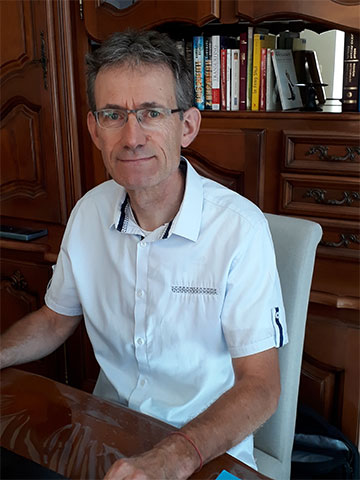
Thierry Lépine
In this installment of Senior Member Insights, OPN talks with Thierry Lépine, an associate professor at the Institut d’Optique, France, since 1992, where he teaches optical design, theory of aberrations, radiometry and optical detection. Lépine received his Ph.D. in optics in 1991 from the Institut d’Optique and Université Paris-Saclay, France.
His research interests are in the design, simulation and analysis of imagery optical systems for applications in astronomy, space and ophthalmology. Since 2014, he has been a visiting professor at the National Astronomical Research Institute of Thailand.
He was also involved in the creation in 2019 of FO-RS, the French center on freeform optics. He is a senior member of Optica and SPIE and a member of the French Optical Society.
What first interested you in pursuing science?
I became interested in science, and especially optics, at an early age. I have been an amateur astronomer since I was 8 years old, and two years later, I built my first refractor. I was also interested in microscopy, minerals, photography and radio communications. So, for me, studying science was an obvious choice and a great pleasure!
If your 10-years-younger self was looking at your career now, what would he be most surprised by?
I am an associate professor of optics at the French Institut d’Optique. I am fortunate to have an exciting job that doesn’t feel like work. And it’s a job that gives you a lot of freedom because you can (almost) choose your research topics
What tips for successful networking do you have for early-career professionals?
You have to go to conferences, workshops and summer schools and use certain social networks, like LinkedIn. It is also important to join optical societies, as their usefulness is no longer in question!
What’s the best career decision you’ve ever made, and why?
Doing a thesis! Right after, I went to work in industry, but thanks to the thesis, I was able to come back to a university, where I felt better.
What skills do you think are most important for someone interested in a career like yours?
You need a lot of motivation and perseverance, and also a bit of luck because positions at a university are rare and there are many good candidates.
Describe a major turning point in your career. Was there a specific action/accomplishment that got you there?
After being hired as an associate professor at the Institut d’Optique, I first worked for 10 years in the field of ultrafast lasers and nonlinear optics. Then in 1999, I had the opportunity to change my activity, and I joined Alain Léger’s team at the Institut d’Astrophysique Spatiale, France, to work on the ESA Darwin space mission. Since then, I’ve been working in the field of optical instrumentation for astronomy and space, and the amateur astronomer that I remain is fulfilled!
“ You have to do what you love, and don’t hesitate to get out of your comfort zone because there are plenty of good opportunities. ”
—Thierry Lépine
What is one piece of advice that you wish you were given as a student/early in your career?
You have to do what you love, and don’t hesitate to get out of your comfort zone because there are plenty of good opportunities. It’s easy when you’re young.
What have you learned by being a mentor to others, and what have you learned from mentors who helped shepherd your career?
I made several decisive encounters in my career.
During my master’s internship in 1986, I worked for six months in Jean-Claude Diels’ team at CAQE (Center for Applied Quantum Electronics, ancestor of CREOL) at the University of North Texas, USA. In the laboratory, I met M.J. Soileau, Eric Van Stryland, David Hagan and many others who became leading people in optics.
Then, in 1999, I left the field of ultrafast lasers and was able to join Alain Léger’s team at the Institut d’Astrophysique Spatiale to work on instrumental projects for space. Finally, in 2014, I met Jannick Rolland and Herbert Gross, who introduced me to freeform surfaces and the theory of nodal aberrations. I also met Antoine Labeyrie that year, one of the fathers of stellar interferometry with A. Michelson, and I continue to be involved in his hypertelescope project.
All these people have influenced my career. It is one of the assets of our profession to be able to meet exceptional people and to be able to exchange and work with them. I was and still am impressed by their motivation, perseverance and ethics. They are of course role models for me.
During my career, I have also supervised more than 20 Ph.D. students, whom I have tried to guide as well as possible. I have learned a lesson of humility from them: we are mainly transmitters of knowledge, and we must pass on to young people what our masters have taught us. I am very proud of my students’ success, some of them having even surpassed their instructor.
At this point in your career, what are you most looking forward to next?
I don’t expect anything in particular. I love my job for the freedom it gives me and because it is intellectually very rewarding. That is enough for me. I trust chance and luck to seize new opportunities.
Outside of work, what is your favorite thing to do in your free time, and why?
I take care of my family of course. I also do a lot of sports, and I am still a very active amateur astronomer and also an amateur radio operator (like James Wyant). And with all this, time goes by very (too) fast! Carpe diem.
